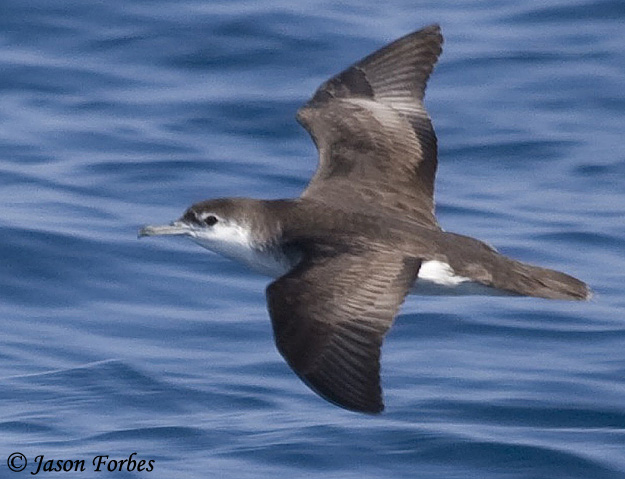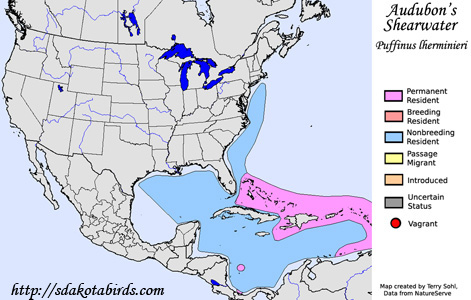| Length: 12 inches | Wingspan: 28 inches | Seasonality: Non-resident in South Dakota |
| ID Keys: Dark brownish upperparts, white underparts, white spot in front of eye, smallest North American Shearwater | ||
 The
Audubon's Shearwater is the smallest of the shearwaters that visit North
America. They can be found in tropical waters of the Indian, Atlantic,
and Pacific Oceans, strongly preferring warm water areas. In the
United States, they are found in the Gulf of Mexico, as well as the East
Coast, where they are typically found far from shore, foraging over the warm
waters of the Gulf Stream in the late summer and early fall when water
temperatures are at their highest. Unlike some other Shearwater
species, they are typically found foraging by themselves. They also do
not often follow fishing vessels for scraps, as some shearwaters do.
The
Audubon's Shearwater is the smallest of the shearwaters that visit North
America. They can be found in tropical waters of the Indian, Atlantic,
and Pacific Oceans, strongly preferring warm water areas. In the
United States, they are found in the Gulf of Mexico, as well as the East
Coast, where they are typically found far from shore, foraging over the warm
waters of the Gulf Stream in the late summer and early fall when water
temperatures are at their highest. Unlike some other Shearwater
species, they are typically found foraging by themselves. They also do
not often follow fishing vessels for scraps, as some shearwaters do.
Habitat: Nests on islands in scattered locations throughout the tropics of the world, using rocky islands, islands with softer soil suitable for nest burrows, or vegetated islands that offer protected spots for ground-nesting. Outside of the breeding season, they can be found in warm waters in most of the world's oceans.
Diet: Feeds mostly on small fish and squid.
Behavior: Forages by diving under the ocean's surface and swimming underwater after prey. They will also sometimes swim and grab prey at or near the ocean's surface.
Nesting: Nests in a underground burrow, in a crevice in rocky area, or on the ground in dense vegetation. The nest itself is either non-existent or a very sparse collection of vegetation and debris. The female lays a single egg, and both the male and female help to incubate it. After it hatches, both parents tend to the nestling.
Interactive eBird Map: Click to access an interactive eBird Map of Audubon's Shearwater sightings
Song: Usually silent, but will occasionally give a high-pitched whining call.
Migration: Widespread distribution, with birds breeding in the Caribbean, the western and Central Pacific, and the Indian Oceans. Outside of the breeding season, they range widely across warmer waters throughout much of the world.
Similar Species: In range, most likely to be confused with the Manx Shearwater.
Conservation Status: Populations are large, spread over a wide geographic area, and appear to be stable. The IUCN has listed the Audubon's Shearwater as a species of "Least Concern".
Further Information: 1) BirdLife International - Audubon's Shearwater
2) WhatBird - Audubon's Shearwater
3) Audubon Guide - Audubon's Shearwater
Photo Information: Photo taken by Jason Forbes - Photo licensed under Creative Commons Attribution NonCommercial NoDerivs 2.0 Generic license.
| Click below for a higher-resolution map |
 |
| South Dakota Status: Non-resident in South Dakota |
Additional Audubon's Shearwater Photos (coming soon!!)
